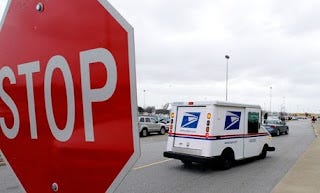Postal service is spying on every piece of mail for law enforcement

The Mail Isolation Control and Tracking program, in which Postal Service computers photograph the exterior of every piece of paper mail that is processed in the United States — about 160 billion pieces last year. It is not known how long the government saves the images.
Together, the two programs show that postal mail is subject to the same kind of scrutiny that the National Security Agency has given to telephone calls and e-mail.
The mail covers program, is more than a century old but is still considered a powerful tool. At the request of law enforcement officials, postal workers record information from the outside of letters and parcels before they are delivered. (Opening the mail would require a warrant.) The information is sent to the law enforcement agency that asked for it. Tens of thousands of pieces of mail each year undergo this scrutiny.
The Mail Isolation Control and Tracking program was created after the anthrax attacks in late 2001 that killed five people, including two postal workers. Highly secret, it seeped into public view last month when the F.B.I. cited it in its investigation of ricin-laced letters sent to President Obama and Mayor Michael R. Bloomberg. It enables the Postal Service to retrace the path of mail at the request of law enforcement. No one disputes that it is sweeping.
“In the past, mail covers were used when you had a reason to suspect someone of a crime,” said Mark D. Rasch, who started a computer crimes unit in the fraud section of the criminal division of the Justice Department and worked on several fraud cases using mail covers. “Now it seems to be, ‘Let’s record everyone’s mail so in the future we might go back and see who you were communicating with.’ Essentially you’ve added mail covers on millions of Americans.”
Bruce Schneier, a computer security expert and an author, said whether it was a postal worker taking down information or a computer taking images, the program was still an invasion of privacy.
“Basically they are doing the same thing as the other programs, collecting the information on the outside of your mail, the metadata, if you will, of names, addresses, return addresses and postmark locations, which gives the government a pretty good map of your contacts, even if they aren’t reading the contents,” he said.
Other agencies, including the Drug Enforcement Administration and the Department of Health and Human Services, have used mail covers to track drug smugglers and Medicare fraud.
“It’s a treasure trove of information,” said James J. Wedick, a former F.B.I. agent who spent 34 years at the agency and who said he used mail covers in a number of investigations, including one that led to the prosecution of several elected officials in California on corruption charges. “Looking at just the outside of letters and other mail, I can see who you bank with, who you communicate with — all kinds of useful information that gives investigators leads that they can then follow up on with a subpoena.”
But, he said: “It can be easily abused because it’s so easy to use and you don’t have to go through a judge to get the information. You just fill out a form.”
For mail cover requests, law enforcement agencies submit a letter to the Postal Service, which can grant or deny a request without judicial review. Law enforcement officials say the Postal Service rarely denies a request. In other government surveillance programs, like wiretaps, a federal judge must sign off on the requests.
The mail cover surveillance requests are granted for about 30 days, and can be extended for up to 120 days. There are two kinds of mail covers: those related to criminal activity and those requested to protect national security. Criminal activity requests average 15,000 to 20,000 per year, said law enforcement officials, who spoke on the condition of anonymity because they are prohibited by law from discussing them. The number of requests for antiterrorism mail covers has not been made public.
Law enforcement officials need warrants to open the mail, although President George W. Bush asserted in a signing statement in 2007 that the federal government had the authority to open mail without warrants in emergencies or in foreign intelligence cases.
Court challenges to mail covers have generally failed because judges have ruled that there is no reasonable expectation of privacy for information contained on the outside of a letter. Officials in both the Bush and Obama administrations, in fact, have used the mail-cover court rulings to justify the N.S.A.’s surveillance programs, saying the electronic monitoring amounts to the same thing as a mail cover. Congress briefly conducted hearings on mail cover programs in 1976, but has not revisited the issue.
http://www.nytimes.com/2013/07/04/us/monitoring-of-snail-mail.html?_r=1&
http://www.thesmokinggun.com/documents/woman-arrested-for-obama-bloomberg-ricin-letters-687435
FOI request: Mail Isolation Control and Tracking (MICT) [USPS]
https://www.muckrock.com/foi/united-states-of-america-10/mail-isolation-control-and-tracking-mict-usps-5970/


